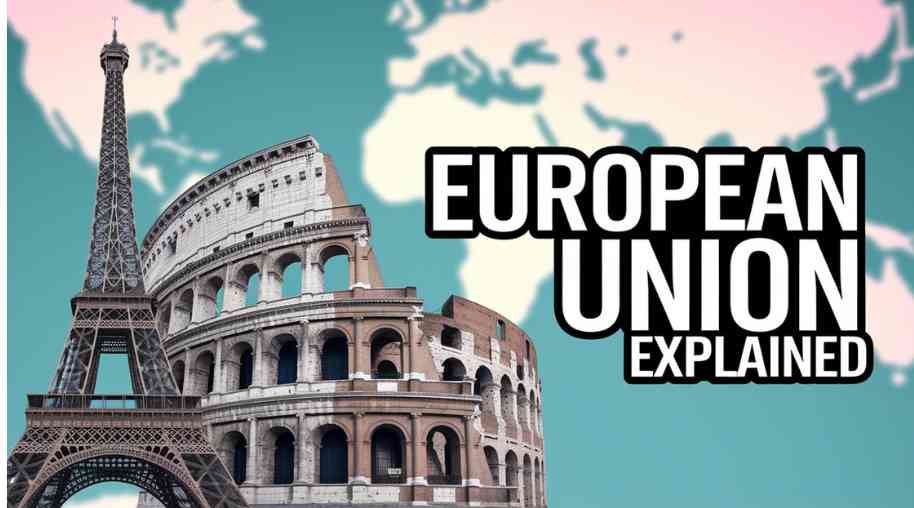EU Full Form-European Union
by Shashi Gaherwar
0 1989
European Union (EU): History, Structure, Benefits, and Global Impact
The European Union (EU) is a political and economic union comprising 27 member states primarily located in Europe. It fosters economic cooperation, political stability, and free trade among its members. The EU plays a significant role in global diplomacy, economic policies, and human rights advocacy.

This article provides an overview of the EU's history, governance structure, benefits, challenges, and its influence on global affairs.
History of the European Union
The origins of the EU date back to World War II, when European leaders sought economic and political cooperation to prevent future conflicts.
- 1951 – European Coal and Steel Community (ECSC)
- Founded by Belgium, France, Italy, Luxembourg, Netherlands, and West Germany.
- Aimed to integrate coal and steel industries to prevent future wars.
- 1957 – Treaty of Rome
- Established the European Economic Community (EEC).
- Focused on economic cooperation and trade liberalization.
- 1993 – Formation of the EU (Maastricht Treaty)
- Transformed the EEC into the European Union (EU).
- Introduced common policies in economy, defense, foreign affairs, and justice.
- 1999 – Introduction of the Euro (€)
- The Euro currency was introduced for financial transactions.
- Physical banknotes and coins launched in 2002.
- 2009 – Lisbon Treaty
- Strengthened EU governance and established the European Council President.
- Enhanced democratic decision-making and external policy coordination.
Structure of the European Union
The EU functions through a complex but democratic institutional structure, ensuring representation for all member states.
- European Commission
- Executive body responsible for proposing laws, implementing policies, and managing the EU budget.
- Led by the President of the European Commission.
- European Parliament
- Legislative branch representing EU citizens.
- Members of the European Parliament (MEPs) are directly elected by EU citizens.
- Responsible for approving laws, budgets, and overseeing the Commission.
- European Council
- Comprises heads of state or government of member countries.
- Sets EU's political direction and priorities.
- Led by the President of the European Council.
- Council of the European Union
- Represents national governments.
- Works with the European Parliament to pass EU laws and policies.
- Court of Justice of the European Union (CJEU)
- Ensures uniform application of EU laws.
- Resolves disputes between member states and EU institutions.
- European Central Bank (ECB)
- Manages the Euro currency and monetary policy.
- Ensures financial stability across the Eurozone.
Key Benefits of the European Union
The EU provides significant advantages to its members and citizens:
- Economic Integration and Free Trade
- Single Market allows free movement of goods, services, capital, and people.
- Businesses benefit from lower trade barriers and a common regulatory framework.
- Common Currency – The Euro (€)
- Reduces exchange rate risks and transaction costs.
- Facilitates easier trade and investment among Eurozone members.
- Political Stability and Cooperation
- Strengthens diplomatic ties and prevents conflicts between member states.
- Unified stance on international issues like climate change, human rights, and trade policies.
- Freedom of Movement
- EU citizens can live, work, and study freely across member countries.
- The Schengen Area allows passport-free travel across most EU nations.
- Funding and Development Programs
- The EU provides financial aid for infrastructure, research, and innovation.
- Funds initiatives supporting education, agriculture, and regional development.
Challenges Facing the European Union
Despite its success, the EU faces several challenges:
- Brexit and Political Fragmentation
- The UK's exit from the EU (Brexit) in 2020 highlighted internal divisions.
- Other nationalist movements in Europe advocate for reduced EU influence.
- Economic Disparities
- Some EU countries, like Germany and France, dominate economically.
- Weaker economies in Eastern and Southern Europe struggle with development.
- Immigration and Refugee Crisis
- Influx of refugees from conflict zones like Syria and Africa creates economic and social tensions.
- Member states have differing immigration policies, leading to disputes.
- Security and Defense
- The EU lacks a unified military force, relying on NATO for defense.
- Rising tensions with Russia, China, and the US require a stronger foreign policy strategy.
The European Union’s Global Influence
The EU is a powerful global entity in economics, politics, and international relations:
- World’s Largest Economic Bloc
- The EU accounts for more than 15% of global GDP.
- Major trade partner for China, the US, and developing nations.
- Leader in Climate and Sustainability
- The EU Green Deal aims for carbon neutrality by 2050.
- Supports renewable energy, carbon emissions reduction, and environmental protection.
- Human Rights and Democracy Promotion
- Enforces strict human rights, labor rights, and democratic governance policies.
- Sanctions countries violating democratic norms.
- Technology and Innovation Hub
- Invests in AI, digital transformation, and space exploration (Galileo satellite program).
- Promotes cybersecurity and digital privacy laws.
Future of the European Union
The EU continues to evolve to address global challenges:
- Stronger Defense Cooperation: Moving towards an integrated European defense strategy.
- Expansion Possibilities: Ukraine, Moldova, and Balkan countries are seeking EU membership.
- Economic Growth & Digital Transformation: Increased focus on AI, automation, and fintech.
- Stronger Climate Action: Achieving a net-zero carbon footprint by 2050.
The European Union (EU) remains a cornerstone of economic stability, political unity, and global influence. Despite challenges such as Brexit, economic disparities, and geopolitical tensions, the EU continues to push forward with initiatives promoting economic growth, sustainability, and digital innovation. Its ability to adapt and evolve will determine its role in shaping the future of Europe and beyond.
Further Learning Resources
If you’re passionate about building a successful blogging website, check out this helpful guide at Coding Tag – How to Start a Successful Blog. It offers practical steps and expert tips to kickstart your blogging journey!
For dedicated UPSC exam preparation, we highly recommend visiting www.iasmania.com. It offers well-structured resources, current affairs, and subject-wise notes tailored specifically for aspirants. Start your journey today!

Share:








Comments
Waiting for your comments